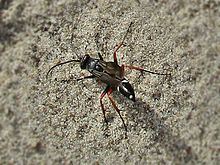Suborder Apocrita Rank Species | Family Pompilidae | |
 | ||
Similar Episyron, Evagetes, Ceropales maculata, Pompilus cinereus, Arachnospila | ||
Spider hunting wasp episyron rufipes
Episyron rufipes, the red-legged spider wasp, is a red and black or completely black spider-hunting wasp.
Contents
- Spider hunting wasp episyron rufipes
- Rotbeinige wegwespe episyron rufipes
- Description
- Habitat
- Biology
- Distribution
- References
Rotbeinige wegwespe episyron rufipes
Description
8-12.5 mm in length. Adults are mainly black with white spots on the abdomen with the two rear legs having the middle leg, tibia and femure coloured red.
Habitat
Associated with dry sandy habitats such as coastal dunes, landslips and grasslands; as well as inland heathlands (e.g. Breckland), gravel pits and gardens on sandy soils.
Biology
Excavates burrows in loose sandy soil using specialised tarsal combs often in aggregations of burrows created by females. The burrows are usually stocked with orb-spiders, mainly Meta and Araneus spp. although Lycosidae may also be predated. The prey are temporarily hung on a nearby plant whilst the burrow is dug. Some females steal the prey captured by its neighbour and females will even fight for the possession of another female's prey, i.e. kleptoparasitism. Eventually some females learn to steal the spiders in the burrow, either by driving away the rightful owner while she was sealing up the burrow, or by hunting through the soil around the aggregated burrows to find sealed burrows. .
In Britain the flight period of adults is June to August.
Both sexes of E rufipes are often seen visiting the flowers of umbellifers for nectar.
E rufipes nests are parasitised by the Spider Wasp Evagetes pectinipes. the female of which eats the egg of Episyron and then replaces it with her own egg before the nest is resealed. E . rufipes is also parasitised by Ceropales maculata.
Distribution
Western Europe to Central Asia. In Britain it is widespread and locally common in coastal areas of the south as far north as Yorkshire and Lancashire. It is less common in the north.
